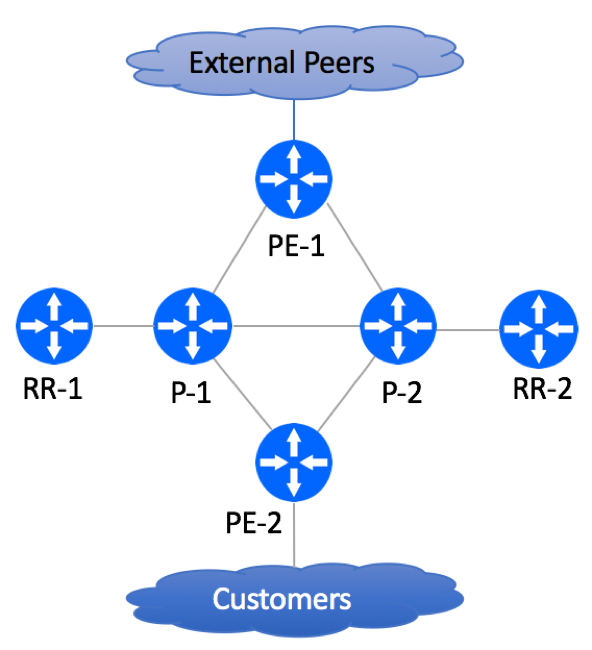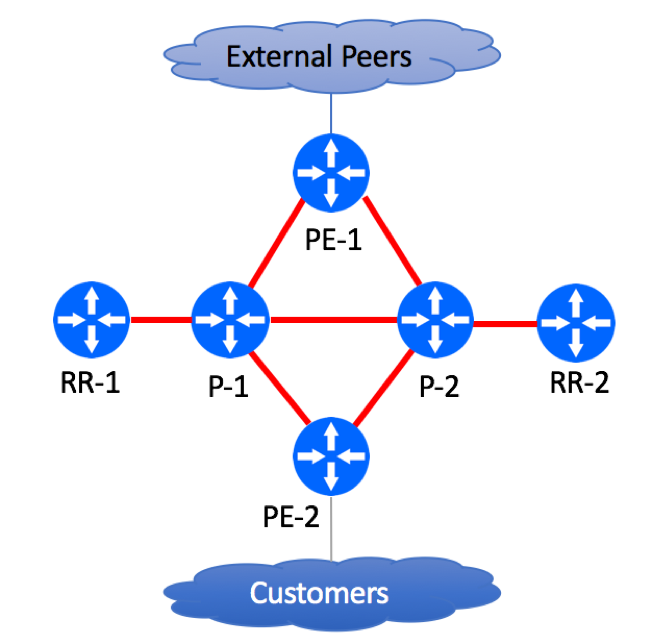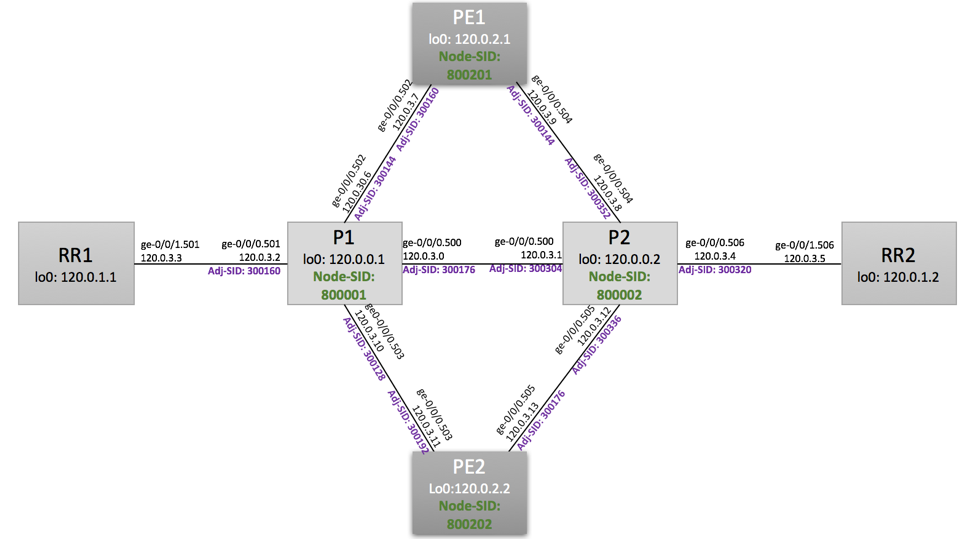Step-by-step migration from LDP-based design to Segment Routing topology in Juniper environment. In this example, we will be using IS-IS as IGP protocol.
Initial Configuration
Today, we’ll perform step-by-step migration of MPLS network from LDP to Segment Routing.
Our starting point is the logical topology depicted below. It represents a typical Service Provider Network with two PE nodes, two P nodes, and two dedicated Route-Reflectors.

We are using JunOS version 17.1.
MPLS and IGP Topologies
MPLS and IGP topologies are shown below. IS-IS is used as IGP Routing protocol. All customer routes, including PE-CE point-to-point prefixes, are carried over IBGP.

Initial IGP (IS-IS) and LDP Configuration
P1
set protocols isis level 2 wide-metrics-only set protocols isis level 1 disable set protocols isis interface all point-to-point set protocols isis interface fxp0.0 disable set protocols ldp transport-address router-id set protocols ldp interface all set protocols ldp interface fxp0.0 disable
P2
set protocols isis level 2 wide-metrics-only set protocols isis level 1 disable set protocols isis interface all point-to-point set protocols isis interface fxp0.0 disable set protocols ldp transport-address router-id set protocols ldp interface all set protocols ldp interface fxp0.0 disable set protocols ldp igp-synchronization holddown-interval 30
PE-1
set protocols isis level 1 disable set protocols isis level 2 wide-metrics-only set protocols isis interface ge-0/0/0.502 point-to-point set protocols isis interface ge-0/0/0.504 point-to-point set protocols isis interface lo0.0 set protocols ldp transport-address router-id set protocols ldp interface ge-0/0/0.502 set protocols ldp interface ge-0/0/0.504 set protocols ldp igp-synchronization holddown-interval 30
PE-2
set protocols isis level 2 wide-metrics-only set protocols isis level 1 disable set protocols isis interface ge-0/0/0.503 point-to-point set protocols isis interface ge-0/0/0.505 point-to-point set protocols isis interface lo0.0 set protocols ldp transport-address router-id set protocols ldp interface ge-0/0/0.503 set protocols ldp interface ge-0/0/0.505 set protocols ldp igp-synchronization holddown-interval 30
Pre-Migration Network State
MPLS Forwarding Tables are populated with LDP-originated LDP labels.
P1
P1> show route table mpls.0 … 300208 *[LDP/9] 00:19:56, metric 1 > to 120.0.3.7 via ge-0/0/0.502, Pop 300208(S=0) *[LDP/9] 00:19:56, metric 1 > to 120.0.3.7 via ge-0/0/0.502, Pop 300224 *[LDP/9] 00:19:32, metric 1 > to 120.0.3.11 via ge-0/0/0.503, Pop 300224(S=0) *[LDP/9] 00:19:32, metric 1 > to 120.0.3.11 via ge-0/0/0.503, Pop
P2
root@P2-vMX> show route table mpls.0 … 300272 *[LDP/9] 00:22:24, metric 1 > to 120.0.3.9 via ge-0/0/0.504, Pop 300272(S=0) *[LDP/9] 00:22:24, metric 1 > to 120.0.3.9 via ge-0/0/0.504, Pop 300288 *[LDP/9] 00:21:27, metric 1 > to 120.0.3.13 via ge-0/0/0.505, Pop 300288(S=0) *[LDP/9] 00:21:27, metric 1 > to 120.0.3.13 via ge-0/0/0.505, Pop
PE-1
PE1-vMX> show route 120.0.30.0 inet.0: 37 destinations, 40 routes (37 active, 0 holddown, 0 hidden) + = Active Route, - = Last Active, * = Both 120.0.30.0/24 *[BGP/170] 00:18:07, localpref 100, from 120.0.1.1 AS path: 65001 I, validation-state: unverified > to 120.0.3.6 via ge-0/0/0.502, Push 300224 to 120.0.3.8 via ge-0/0/0.504, Push 300288 [BGP/170] 00:18:07, localpref 100, from 120.0.1.2 AS path: 65001 I, validation-state: unverified > to 120.0.3.6 via ge-0/0/0.502, Push 300224 to 120.0.3.8 via ge-0/0/0.504, Push 300288
PE-2
PE-2> show route 70.0.0.0 inet.0: 67 destinations, 73 routes (58 active, 0 holddown, 9 hidden) + = Active Route, - = Last Active, * = Both 70.0.0.0/8 *[BGP/170] 00:17:02, localpref 40, from 120.0.1.1 AS path: 701 I, validation-state: unverified > to 120.0.3.12 via ge-0/0/0.505, Push 300272 to 120.0.3.10 via ge-0/0/0.503, Push 300208 [BGP/170] 00:17:02, localpref 40, from 120.0.1.2 AS path: 701 I, validation-state: unverified > to 120.0.3.12 via ge-0/0/0.505, Push 300272 to 120.0.3.10 via ge-0/0/0.503, Push 300208
Enabling Segment Routing
Basic SR configuration is very simple. In fact, it is easier to enable SR than it is to configure LDP. All you need to do is to allow ‘source-packet-routing’ under protocol IS-IS and specify unique node identifier for each SR-enabled device.
Configure Segment Routing with Node Segment Identifiers
P1
set protocols isis source-packet-routing node-segment ipv4-index 1
P2
set protocols isis source-packet-routing node-segment ipv4-index 2
PE-1
set protocols isis source-packet-routing node-segment ipv4-index 201
PE-2
set protocols isis source-packet-routing node-segment ipv4-index 202
Make sure that Node SIDs and Adjacency SIDs are being advertised and received
After completing configuration, Node-SIDs (global significance) and Adjacency-SIDs (local significance) will be advertised via IS-IS.
The following diagram depicts SIDs that were assigned in our topology:

Please note that SR was not enabled on Route-Reflectors, so there are no SIDs associated with RR links and nodes.
Verify Adjacency SID labels:
P1
root@P1-vMX> show isis adjacency detail P2-vMX Interface: ge-0/0/0.500, Level: 2, State: Up, Expires in 21 secs Priority: 0, Up/Down transitions: 1, Last transition: 15:55:06 ago Circuit type: 2, Speaks: IP, IPv6 Topologies: Unicast Restart capable: Yes, Adjacency advertisement: Advertise IP addresses: 120.0.3.1 Level 2 IPv4 Adj-SID: 300176 P3-RR1 Interface: ge-0/0/0.501, Level: 2, State: Up, Expires in 24 secs Priority: 0, Up/Down transitions: 1, Last transition: 3d 15:43:08 ago Circuit type: 2, Speaks: IP, IPv6 Topologies: Unicast Restart capable: Yes, Adjacency advertisement: Advertise IP addresses: 120.0.3.3 Level 2 IPv4 Adj-SID: 300160 PE1-vMX Interface: ge-0/0/0.502, Level: 2, State: Up, Expires in 25 secs Priority: 0, Up/Down transitions: 1, Last transition: 3d 15:43:33 ago Circuit type: 2, Speaks: IP, IPv6 Topologies: Unicast Restart capable: Yes, Adjacency advertisement: Advertise IP addresses: 120.0.3.7 Level 2 IPv4 Adj-SID: 300144 PE2-vMX Interface: ge-0/0/0.503, Level: 2, State: Up, Expires in 22 secs Priority: 0, Up/Down transitions: 1, Last transition: 3d 15:43:11 ago Circuit type: 2, Speaks: IP, IPv6 Topologies: Unicast Restart capable: Yes, Adjacency advertisement: Advertise IP addresses: 120.0.3.11 Level 2 IPv4 Adj-SID: 300128
P2
root@P2-vMX> show isis adjacency detail P1-vMX Interface: ge-0/0/0.500, Level: 2, State: Up, Expires in 26 secs Priority: 0, Up/Down transitions: 1, Last transition: 18:18:21 ago Circuit type: 2, Speaks: IP, IPv6 Topologies: Unicast Restart capable: Yes, Adjacency advertisement: Advertise IP addresses: 120.0.3.0 Level 2 IPv4 Adj-SID: 300304 PE1-vMX Interface: ge-0/0/0.504, Level: 2, State: Up, Expires in 25 secs Priority: 0, Up/Down transitions: 1, Last transition: 18:19:21 ago Circuit type: 2, Speaks: IP, IPv6 Topologies: Unicast Restart capable: Yes, Adjacency advertisement: Advertise IP addresses: 120.0.3.9 Level 2 IPv4 Adj-SID: 300352 PE2-vMX Interface: ge-0/0/0.505, Level: 2, State: Up, Expires in 21 secs Priority: 0, Up/Down transitions: 1, Last transition: 18:19:46 ago Circuit type: 2, Speaks: IP, IPv6 Topologies: Unicast Restart capable: Yes, Adjacency advertisement: Advertise IP addresses: 120.0.3.13 Level 2 IPv4 Adj-SID: 300336 P4-RR2 Interface: ge-0/0/0.506, Level: 2, State: Up, Expires in 20 secs Priority: 0, Up/Down transitions: 1, Last transition: 18:19:20 ago Circuit type: 2, Speaks: IP, IPv6 Topologies: Unicast Restart capable: Yes, Adjacency advertisement: Advertise IP addresses: 120.0.3.5 Level 2 IPv4 Adj-SID: 300320
PE-1
root@PE1-vMX> show isis adjacency detail P1-vMX Interface: ge-0/0/0.502, Level: 2, State: Up, Expires in 21 secs Priority: 0, Up/Down transitions: 3, Last transition: 3d 18:11:45 ago Circuit type: 2, Speaks: IP, IPv6 Topologies: Unicast Restart capable: Yes, Adjacency advertisement: Advertise IP addresses: 120.0.3.6 Level 2 IPv4 Adj-SID: 300160 P2-vMX Interface: ge-0/0/0.504, Level: 2, State: Up, Expires in 21 secs Priority: 0, Up/Down transitions: 5, Last transition: 18:24:17 ago Circuit type: 2, Speaks: IP, IPv6 Topologies: Unicast Restart capable: Yes, Adjacency advertisement: Advertise IP addresses: 120.0.3.8 Level 2 IPv4 Adj-SID: 300144
PE-2
root@PE2-vMX> show isis adjacency detail P1-vMX Interface: ge-0/0/0.503, Level: 2, State: Up, Expires in 21 secs Priority: 0, Up/Down transitions: 3, Last transition: 3d 18:11:45 ago Circuit type: 2, Speaks: IP, IPv6 Topologies: Unicast Restart capable: Yes, Adjacency advertisement: Advertise IP addresses: 120.0.3.10 Level 2 IPv4 Adj-SID: 300192 P2-vMX Interface: ge-0/0/0.505, Level: 2, State: Up, Expires in 21 secs Priority: 0, Up/Down transitions: 3, Last transition: 18:25:04 ago Circuit type: 2, Speaks: IP, IPv6 Topologies: Unicast Restart capable: Yes, Adjacency advertisement: Advertise IP addresses: 120.0.3.12 Level 2 IPv4 Adj-SID: 300176
Verify Global SID labels
On one of the nodes, verify IS-IS database to make sure that SPRING sub-TLVs have been propagated. MPLS Label for a given Global-SID will be calculated as SID Label Value (800,000) plus Node SID Index.
For example, ipv4-index value 201 was assigned PE-1:
set protocols isis source-packet-routing node-segment ipv4-index 201
This means that global MPLS Label 800,201 can be used to forward traffic to PE-1:
800,000 + 201 = 800,201
root@P1-vMX> show isis database extensive | no-more
…
IS-IS level 2 link-state database:
P1-vMX.00-00 Sequence: 0x1cc, Checksum: 0xbafd, Lifetime: 1055 secs
…
TLVs:
Area address: 49.0002 (3)
LSP Buffer Size: 1492
Speaks: IP
Speaks: IPV6
IP router id: 120.0.0.1
IP address: 120.0.0.1
Hostname: P1-vMX
Router Capability: Router ID 120.0.0.1, Flags: 0x00
SPRING Capability - Flags: 0xc0(I:1,V:1), Range: 4096, SID-Label: 800000
SPRING Algorithm - Algo: 0
IS extended neighbor: P2-vMX.00, Metric: default 10
IP address: 120.0.3.0
Neighbor's IP address: 120.0.3.1
Local interface index: 336, Remote interface index: 341
P2P IPV4 Adj-SID - Flags:0x30(F:0,B:0,V:1,L:1,S:0), Weight:0, Label: 300176
IS extended neighbor: P3-RR1.00, Metric: default 10
IP address: 120.0.3.2
Neighbor's IP address: 120.0.3.3
Local interface index: 339, Remote interface index: 74
P2P IPV4 Adj-SID - Flags:0x30(F:0,B:0,V:1,L:1,S:0), Weight:0, Label: 300160
IS extended neighbor: PE1-vMX.00, Metric: default 10
IP address: 120.0.3.6
Neighbor's IP address: 120.0.3.7
Local interface index: 340, Remote interface index: 333
P2P IPV4 Adj-SID - Flags:0x30(F:0,B:0,V:1,L:1,S:0), Weight:0, Label: 300144
IS extended neighbor: PE2-vMX.00, Metric: default 10
IP address: 120.0.3.10
Neighbor's IP address: 120.0.3.11
Local interface index: 341, Remote interface index: 334
P2P IPV4 Adj-SID - Flags:0x30(F:0,B:0,V:1,L:1,S:0), Weight:0, Label: 300128
IP extended prefix: 120.0.3.0/31 metric 10 up
IP extended prefix: 120.0.3.2/31 metric 10 up
IP extended prefix: 120.0.3.6/31 metric 10 up
IP extended prefix: 120.0.3.10/31 metric 10 up
IP extended prefix: 120.0.0.1/32 metric 0 up
8 bytes of subtlvs
Node SID, Flags: 0x40(R:0,N:1,P:0,E:0,V:0,L:0), Algo: SPF(0), Value: 1
No queued transmissions
<OMMITED FOR P2>
PE1-vMX.00-00 Sequence: 0x1c7, Checksum: 0x9da4, Lifetime: 850 secs
IPV4 Index: 201
Node Segment Blocks Advertised:
Start Index : 0, Size : 4096, Label-Range: [ 800000, 804095 ]
IS neighbor: P1-vMX.00 Metric: 10
Two-way fragment: P1-vMX.00-00, Two-way first fragment: P1-vMX.00-00
IS neighbor: P2-vMX.00 Metric: 10
Two-way fragment: P2-vMX.00-00, Two-way first fragment: P2-vMX.00-00
IP prefix: 120.0.2.1/32 Metric: 0 Internal Up
IP prefix: 120.0.3.6/31 Metric: 10 Internal Up
IP prefix: 120.0.3.8/31 Metric: 10 Internal Up
Header: LSP ID: PE1-vMX.00-00, Length: 203 bytes
Allocated length: 284 bytes, Router ID: 120.0.2.1
Remaining lifetime: 850 secs, Level: 2, Interface: 340
Estimated free bytes: 151, Actual free bytes: 81
Aging timer expires in: 850 secs
Protocols: IP, IPv6
Packet: LSP ID: PE1-vMX.00-00, Length: 203 bytes, Lifetime: 1196 secs
Checksum: 0x9da4, Sequence: 0x1c7, Attributes: 0x3 <L1 L2>
NLPID: 0x83, Fixed length: 27 bytes, Version: 1, Sysid length: 0 bytes
Packet type: 20, Packet version: 1, Max area: 0
TLVs:
Area address: 49.0002 (3)
LSP Buffer Size: 1492
Speaks: IP
Speaks: IPV6
IP router id: 120.0.2.1
IP address: 120.0.2.1
Hostname: PE1-vMX
Router Capability: Router ID 120.0.2.1, Flags: 0x00
SPRING Capability - Flags: 0xc0(I:1,V:1), Range: 4096, SID-Label: 800000
SPRING Algorithm - Algo: 0
IS extended neighbor: P2-vMX.00, Metric: default 10
IP address: 120.0.3.9
Neighbor's IP address: 120.0.3.8
Local interface index: 334, Remote interface index: 333
P2P IPV4 Adj-SID - Flags:0x30(F:0,B:0,V:1,L:1,S:0), Weight:0, Label: 300144
IS extended neighbor: P1-vMX.00, Metric: default 10
IP address: 120.0.3.7
Neighbor's IP address: 120.0.3.6
Local interface index: 333, Remote interface index: 340
P2P IPV4 Adj-SID - Flags:0x30(F:0,B:0,V:1,L:1,S:0), Weight:0, Label: 300160
IP extended prefix: 120.0.3.6/31 metric 10 up
IP extended prefix: 120.0.3.8/31 metric 10 up
IP extended prefix: 120.0.2.1/32 metric 0 up
8 bytes of subtlvs
Node SID, Flags: 0x40(R:0,N:1,P:0,E:0,V:0,L:0), Algo: SPF(0), Value: 201
No queued transmissions
PE2-vMX.00-00 Sequence: 0x1cc, Checksum: 0x5b80, Lifetime: 408 secs
IPV4 Index: 202
Node Segment Blocks Advertised:
Start Index : 0, Size : 4096, Label-Range: [ 800000, 804095 ]
IS neighbor: P1-vMX.00 Metric: 10
Two-way fragment: P1-vMX.00-00, Two-way first fragment: P1-vMX.00-00
IS neighbor: P2-vMX.00 Metric: 10
Two-way fragment: P2-vMX.00-00, Two-way first fragment: P2-vMX.00-00
IP prefix: 120.0.2.2/32 Metric: 0 Internal Up
IP prefix: 120.0.3.10/31 Metric: 10 Internal Up
IP prefix: 120.0.3.12/31 Metric: 10 Internal Up
Header: LSP ID: PE2-vMX.00-00, Length: 203 bytes
Allocated length: 284 bytes, Router ID: 120.0.2.2
Remaining lifetime: 408 secs, Level: 2, Interface: 341
Estimated free bytes: 151, Actual free bytes: 81
Aging timer expires in: 408 secs
Protocols: IP, IPv6
Packet: LSP ID: PE2-vMX.00-00, Length: 203 bytes, Lifetime: 1196 secs
Checksum: 0x5b80, Sequence: 0x1cc, Attributes: 0x3 <L1 L2>
NLPID: 0x83, Fixed length: 27 bytes, Version: 1, Sysid length: 0 bytes
Packet type: 20, Packet version: 1, Max area: 0
TLVs:
Area address: 49.0002 (3)
LSP Buffer Size: 1492
Speaks: IP
Speaks: IPV6
IP router id: 120.0.2.2
IP address: 120.0.2.2
Hostname: PE2-vMX
Router Capability: Router ID 120.0.2.2, Flags: 0x00
SPRING Capability - Flags: 0xc0(I:1,V:1), Range: 4096, SID-Label: 800000
SPRING Algorithm - Algo: 0
IS extended neighbor: P1-vMX.00, Metric: default 10
IP address: 120.0.3.11
Neighbor's IP address: 120.0.3.10
Local interface index: 334, Remote interface index: 341
P2P IPV4 Adj-SID - Flags:0x30(F:0,B:0,V:1,L:1,S:0), Weight:0, Label: 300192
IS extended neighbor: P2-vMX.00, Metric: default 10
IP address: 120.0.3.13
Neighbor's IP address: 120.0.3.12
Local interface index: 333, Remote interface index: 334
P2P IPV4 Adj-SID - Flags:0x30(F:0,B:0,V:1,L:1,S:0), Weight:0, Label: 300176
IP extended prefix: 120.0.3.10/31 metric 10 up
IP extended prefix: 120.0.3.12/31 metric 10 up
IP extended prefix: 120.0.2.2/32 metric 0 up
8 bytes of subtlvs
Node SID, Flags: 0x40(R:0,N:1,P:0,E:0,V:0,L:0), Algo: SPF(0), Value: 202
No queued transmissions
Verify Next-Hop Reachability
Now you can verify if inet.3 table got populated with SR routes for Spring-enabled devices.
Indeed, we now have routes originated via ‘L-ISIS’. The routes are not yet being used, as LDP’s Protocol Preference of 9 wins over SR’s preference of 14.
PE-1
root@PE1-vMX> show route 120.0.2.2
inet.0: 37 destinations, 40 routes (37 active, 0 holddown, 0 hidden)
+ = Active Route, - = Last Active, * = Both
120.0.2.2/32 *[IS-IS/18] 20:12:45, metric 20
to 120.0.3.6 via ge-0/0/0.502
> to 120.0.3.8 via ge-0/0/0.504
inet.3: 3 destinations, 6 routes (3 active, 0 holddown, 0 hidden)
+ = Active Route, - = Last Active, * = Both
120.0.2.2/32 *[LDP/9] 04:58:25, metric 1
to 120.0.3.6 via ge-0/0/0.502, Push 300224
> to 120.0.3.8 via ge-0/0/0.504, Push 300288
[L-ISIS/14] 03:51:25, metric 20
to 120.0.3.6 via ge-0/0/0.502, Push 800202
> to 120.0.3.8 via ge-0/0/0.504, Push 800202
PE-2
root@PE2-vMX> show route 120.0.2.1 inet.0: 67 destinations, 73 routes (58 active, 0 holddown, 9 hidden) + = Active Route, - = Last Active, * = Both 120.0.2.1/32 *[IS-IS/18] 20:23:26, metric 20 to 120.0.3.12 via ge-0/0/0.505 > to 120.0.3.10 via ge-0/0/0.503 inet.3: 3 destinations, 6 routes (3 active, 0 holddown, 0 hidden) + = Active Route, - = Last Active, * = Both 120.0.2.1/32 *[LDP/9] 05:09:05, metric 1 to 120.0.3.12 via ge-0/0/0.505, Push 300272 > to 120.0.3.10 via ge-0/0/0.503, Push 300208 [L-ISIS/14] 04:30:21, metric 20 to 120.0.3.12 via ge-0/0/0.505, Push 800201 > to 120.0.3.10 via ge-0/0/0.503, Push 800201
P1
P Nodes can forward traffic (MPLS Swap Operation) for both LDP and SR-generated labels:
P1> show route table mpls.0
…
300128 *[L-ISIS/14] 1d 16:23:09, metric 0
> to 120.0.3.11 via ge-0/0/0.503, Pop
300128(S=0) *[L-ISIS/14] 00:11:55, metric 0
> to 120.0.3.11 via ge-0/0/0.503, Pop
300144 *[L-ISIS/14] 1d 16:23:09, metric 0
> to 120.0.3.7 via ge-0/0/0.502, Pop
300144(S=0) *[L-ISIS/14] 00:11:55, metric 0
> to 120.0.3.7 via ge-0/0/0.502, Pop
300160 *[L-ISIS/14] 1d 16:23:09, metric 0
> to 120.0.3.3 via ge-0/0/0.501, Pop
300160(S=0) *[L-ISIS/14] 00:11:55, metric 0
> to 120.0.3.3 via ge-0/0/0.501, Pop
300176 *[L-ISIS/14] 20:24:29, metric 0
> to 120.0.3.1 via ge-0/0/0.500, Pop
300176(S=0) *[L-ISIS/14] 00:11:55, metric 0
> to 120.0.3.1 via ge-0/0/0.500, Pop
300192 *[LDP/9] 04:36:18, metric 1
> to 120.0.3.1 via ge-0/0/0.500, Pop
300192(S=0) *[LDP/9] 04:36:18, metric 1
> to 120.0.3.1 via ge-0/0/0.500, Pop
300208 *[LDP/9] 04:34:13, metric 1
> to 120.0.3.7 via ge-0/0/0.502, Pop
300208(S=0) *[LDP/9] 04:34:13, metric 1
> to 120.0.3.7 via ge-0/0/0.502, Pop
300224 *[LDP/9] 04:32:15, metric 1
> to 120.0.3.11 via ge-0/0/0.503, Pop
300224(S=0) *[LDP/9] 04:32:15, metric 1
> to 120.0.3.11 via ge-0/0/0.503, Pop
800002 *[L-ISIS/14] 04:36:18, metric 10
> to 120.0.3.1 via ge-0/0/0.500, Pop
800002(S=0) *[L-ISIS/14] 00:11:55, metric 10
> to 120.0.3.1 via ge-0/0/0.500, Pop
800201 *[L-ISIS/14] 04:34:13, metric 10
> to 120.0.3.7 via ge-0/0/0.502, Pop
800201(S=0) *[L-ISIS/14] 00:11:55, metric 10
> to 120.0.3.7 via ge-0/0/0.502, Pop
800202 *[L-ISIS/14] 04:03:59, metric 10
> to 120.0.3.11 via ge-0/0/0.503, Pop
800202(S=0) *[L-ISIS/14] 00:11:55, metric 10
> to 120.0.3.11 via ge-0/0/0.503, Pop
P2
root@P2-vMX> show route table mpls.0
…
300256 *[LDP/9] 04:38:32, metric 1
> to 120.0.3.0 via ge-0/0/0.500, Pop
300256(S=0) *[LDP/9] 04:38:32, metric 1
> to 120.0.3.0 via ge-0/0/0.500, Pop
300272 *[LDP/9] 04:36:27, metric 1
> to 120.0.3.9 via ge-0/0/0.504, Pop
300272(S=0) *[LDP/9] 04:36:27, metric 1
> to 120.0.3.9 via ge-0/0/0.504, Pop
300288 *[LDP/9] 04:34:29, metric 1
> to 120.0.3.13 via ge-0/0/0.505, Pop
300288(S=0) *[LDP/9] 04:34:29, metric 1
> to 120.0.3.13 via ge-0/0/0.505, Pop
300304 *[L-ISIS/14] 04:38:32, metric 0
> to 120.0.3.0 via ge-0/0/0.500, Pop
300304(S=0) *[L-ISIS/14] 00:00:44, metric 0
> to 120.0.3.0 via ge-0/0/0.500, Pop
300320 *[L-ISIS/14] 04:38:32, metric 0
> to 120.0.3.5 via ge-0/0/0.506, Pop
300320(S=0) *[L-ISIS/14] 00:00:44, metric 0
> to 120.0.3.5 via ge-0/0/0.506, Pop
300336 *[L-ISIS/14] 04:38:32, metric 0
> to 120.0.3.13 via ge-0/0/0.505, Pop
300336(S=0) *[L-ISIS/14] 00:00:44, metric 0
> to 120.0.3.13 via ge-0/0/0.505, Pop
300352 *[L-ISIS/14] 04:38:32, metric 0
> to 120.0.3.9 via ge-0/0/0.504, Pop
300352(S=0) *[L-ISIS/14] 00:00:44, metric 0
> to 120.0.3.9 via ge-0/0/0.504, Pop
800001 *[L-ISIS/14] 04:38:32, metric 10
> to 120.0.3.0 via ge-0/0/0.500, Pop
800001(S=0) *[L-ISIS/14] 00:00:44, metric 10
> to 120.0.3.0 via ge-0/0/0.500, Pop
800201 *[L-ISIS/14] 04:36:27, metric 10
> to 120.0.3.9 via ge-0/0/0.504, Pop
800201(S=0) *[L-ISIS/14] 00:00:44, metric 10
> to 120.0.3.9 via ge-0/0/0.504, Pop
800202 *[L-ISIS/14] 04:06:13, metric 10
> to 120.0.3.13 via ge-0/0/0.505, Pop
800202(S=0) *[L-ISIS/14] 00:00:44, metric 10
> to 120.0.3.13 via ge-0/0/0.505, Pop
Deactivate LDP
Now that SR topology is fully configured, you can either completely deactivate LDP or change LDP’s Protocol Preference to make it inferior to SR’s preference.
set protocols ldp preference 15
This would force transit traffic to switch from LDP to SR LSPs.
Before Preference Change:
root@PE2-vMX> show route 70.0.0.0/8
inet.0: 67 destinations, 73 routes (58 active, 0 holddown, 9 hidden)
+ = Active Route, - = Last Active, * = Both
70.0.0.0/8 *[BGP/170] 05:15:37, localpref 40, from 120.0.1.1
AS path: 701 I, validation-state: unverified
> to 120.0.3.12 via ge-0/0/0.505, Push 300272
to 120.0.3.10 via ge-0/0/0.503, Push 300208
[BGP/170] 05:15:37, localpref 40, from 120.0.1.2
AS path: 701 I, validation-state: unverified
> to 120.0.3.12 via ge-0/0/0.505, Push 300272
to 120.0.3.10 via ge-0/0/0.503, Push 300208
After preference change:
root@PE2-vMX> show route 70.0.0.0/8
inet.0: 67 destinations, 73 routes (58 active, 0 holddown, 9 hidden)
+ = Active Route, - = Last Active, * = Both
70.0.0.0/8 *[BGP/170] 00:00:01, localpref 40, from 120.0.1.1
AS path: 701 I, validation-state: unverified
> to 120.0.3.12 via ge-0/0/0.505, Push 800201
to 120.0.3.10 via ge-0/0/0.503, Push 800201
[BGP/170] 00:00:01, localpref 40, from 120.0.1.2
AS path: 701 I, validation-state: unverified
> to 120.0.3.12 via ge-0/0/0.505, Push 800201
to 120.0.3.10 via ge-0/0/0.503, Push 800201
Remove LDP
You can now remove LDP configuration from your MPLS nodes, as the protocol is no longer needed:
delete protocols ldp
Remove LDP Rules from Control Plane Firewall Filter
Firewall filters can be updated to remove LDP terms:
firewall family inet filter accept-protocols term ldp
There is no need to add Segment Routing-specific terms, as SR Updates are carried in IS-IS messages.
